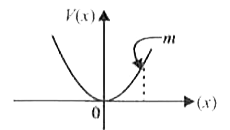A particle of rest mass m0 is travelling, so that its total energy is twice its rest mass energy. It collides with another stationary particle of rest mass m0 to form a new particle. What is the rest mass of the new particle?
√6m0
2m0
2√3m0
3m0
The correct Answer is:D
∵ Total energy of particle =mc2−m0c2 rest mass energy of particle =m0c2 according question,
⇒mc2−m0c2=2m0c2
or m=3m0
When a particle collides with another particle then net mass of new particle will be m=3m0
Similar Questions
A moving particle collides with a stationary particle and imparts kinectic energy to the stationary particle . What percentage of kinectic energy will be transferred to the stationary particle if the mass of stationary particle is 30 times the mass of moving particle ?
View SolutionA particle of mass m travelling with velocity v and kinetic energy E collides elastically to another particle of mass nm, at rest. What is the fraction of total energy retained by the particle of mass m?
View Solution
Knowledge Check
A particle (A) of mass m1 elastically collides with another stationary particle (B) of mass m2. Then :
Am1m2=12 and the particles fly a part in the opposite direction with equal velocities.Bm1m2=13 and the particles fly apart in the opposite direction with equal velocities.Cm1m2=21 and the collision angle between the particles is 60∘ symmetrically.Dm1m2=21 and the particles fly apart symmetrically at an angle 90∘As the speed of a particle increases, its rest mass
AincreasesBdecreasesCremains the sameDchangesA particle of mass m travelling with velocity v and kinetic energy E collides elastically to another particle of mass nm, at rest. What is the fraction of total energy retained by the particle of mass m?
A(n+1n)2B(n+1(n−1)2)C(n−1n+1)2Dnone of these
At what speed must a particle move for its rest mass to be trebled?
View SolutionA relativistic particle with rest mass m cillides with a stationary particle of mass M and activities at reaction leading to formation of new particles: m+M→m1+m2+….., where the rest masses of newly formed particles are written on the right-hand side. Making use of invariance of the quantity E2−p2c2, demonstrate that the threshold kinetic energy of the particle m required for this reaction is defined by Eq.(6.7c).
View SolutionThe velocity of a particle at which the kinetic energy is eqyal to its rest mass energy is
View SolutionA particle of mass m is released from rest and follows a particle as a function of time?

View SolutionA particle of mass m, collides with another stationary particle of mass M. If the particle m stops just after collision, then the coefficient of restitution for collision is equal to
View Solution
